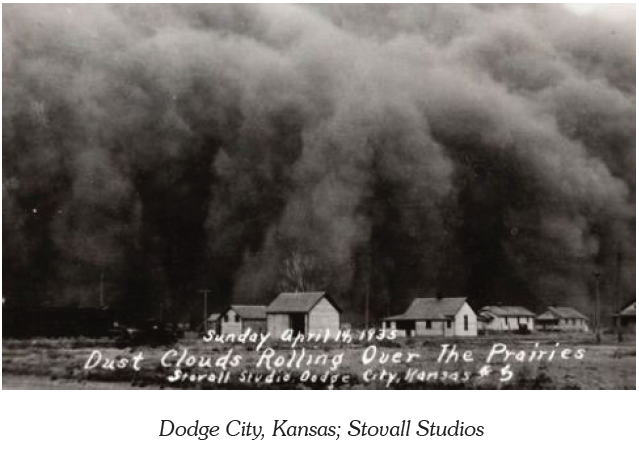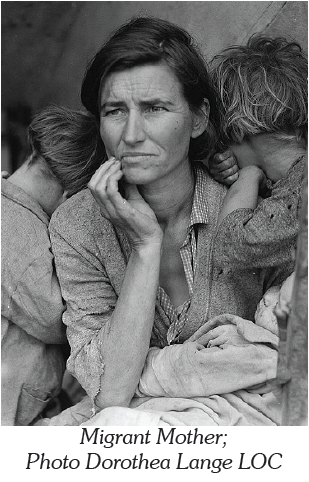From Boom to Dust
Students will learn how the events of World War I helped spark the Great Depression, the Dust Bowl, and the resulting New Deal by watching a video and participating in a round robin, responding in writing to images and sound bites from the Dust Bowl, and observing a wind erosion demonstration.Grades 9-12
Background
Lesson Activities
Recommended Companion Resources
Credits
Author
Debra Spielmaker | Utah Agriculture in the Classroom
Standards
Texas Content Area Standards
-
Principles of Agriculture, Food, and Natural Resources: 130.2.c.1
The student demonstrates professional standards/employability skills as required by business and industry. The student is expected to:
- Principles of Agriculture, Food, and Natural Resources: 130.2.c.1.B: apply competencies related to resources, information, interpersonal skills, problem solving, critical thinking, and systems of operation in agriculture, food, and natural resources.
-
Principles of Agriculture, Food, and Natural Resources: 130.2.c.4
The student explains the historical, current, and future significance of the agriculture, food, and natural resources industry. The student is expected to:
- Principles of Agriculture, Food, and Natural Resources: 130.2.c.4.B: analyze the scope of agriculture, food, and natural resources and its effect upon society.
- Principles of Agriculture, Food, and Natural Resources: 130.2.c.4.C: evaluate significant historical and current agriculture, food, and natural resources developments.
-
United States History Since 1877: 113.41.c.12
Geography. The student understands the impact of geographic factors on major events. The student is expected to analyze the impact of physical and human geographic factors on the Klondike Gold Rush, the Panama Canal, the Dust Bowl, and the levee failure in New Orleans after Hurricane Katrina.
- U.S. History Since 1877: 12: Geography. The student understands the impact of geographic factors on major events. The student is expected to analyze the impact of physical and human geographic factors on the Klondike Gold Rush, the Panama Canal, the Dust Bowl, and the levee failure in New Orleans after Hurricane Katrina.
-
Principles of Agriculture, Food, and Natural Resources: 130.2.c.10
The student develops technical knowledge and skills related to soil systems. The student is expected to:
- Principles of Agriculture, Food, and Natural Resources: 130.2.c.10.B: identify and describe the process of soil formation.
-
United States History Since 1877: 113.41.c.2
History. The student understands traditional historical points of reference in U.S. history from 1877 to the present.
- United States History Since 1877: 2.B: The student is expected to explain the significance of the following years as turning points: 1898 (Spanish-American War), 1914-1918 (World War I), 1929 (the Great Depression begins), 1939-1945 (World War II), 1957 (Sputnik launch ignites U.S.-Soviet space race), 1968 (Martin Luther King Jr. assassination), 1969 (U.S. lands on the moon), 1991 (Cold War ends), 2001 (terrorist attacks on World Trade Center and the Pentagon), and 2008 (election of first black president, Barack Obama).
-
English I: 110.36.c.1
Developing and sustaining foundational language skills: listening, speaking, discussion, and thinking--oral language. The student develops oral language through listening, speaking, and discussion.
- English I: 1.A: The student is expected to engage in meaningful and respectful discourse by listening actively, responding appropriately, and adjusting communication to audiences and purposes.
- English I: 1.D: The student is expected to participate collaboratively, building on the ideas of others, contributing relevant information, developing a plan for consensus building, and setting ground rules for decision making.
-
English II: 110.37.c.1
Developing and sustaining foundation language skills: listening, speaking, discussion, and thinking--oral language. The student develops oral language through listening, speaking, and discussion.
- English II: 1.A: The student is expected to engage in meaningful and respectful discourse by listening actively, responding appropriately, and adjusting communication to audiences and purposes.
- English II: 1.D: The student is expected to participate collaboratively, building on the ideas of others, contributing relevant information, developing a plan for consensus building, and setting ground rules for decision making.
-
English III: 110.38.c.1
Developing and sustaining foundational language skills: listening, speaking, discussion, and thinking--oral language. The student develops oral language through listening, speaking, and discussion.
- English III: 1.A: The student is expected to engage in meaningful and respectful discourse when evaluating the clarity and coherence of a speaker's message and critiquing the impact of a speaker's use of diction and syntax.
- English III: 1.D: The student is expected to participate collaboratively, offering ideas or judgements that are purposeful in moving the team toward goals, asking relevant and insightful questions, tolerating a range of positions and ambiguity in decision making, and evaluating the work of the group based on agreed-upon criteria.
-
English IV: 110.39.c.1
Developing and sustaining foundational language skills: listening, speaking, discussion, and thinking--oral language. The student develops oral language through listening, speaking, and discussion.
- English IV: 1.A: The student is expected to engage in meaningful and respectful discourse when evaluating the clarity and coherence of a speaker's message and critiquing the impact of a speaker's use of diction, syntax, and rhetorical strategies.
- English IV: 1.D: The student is expected to participate collaboratively, offering ideas or judgements that are purposeful in moving the team toward goals, asking relevant and insightful questions, tolerating a range of positions and ambiguity in decision making, and evaluating the work of the group based on agreed-upon criteria.
-
English I: 110.36.c.9
Composition: listening, speaking, reading, writing, and thinking using multiple texts--writing process. The student uses the writing process recursively to compose multiple texts that are legible and use appropriate conventions.
- English I: 9.A: The student is expected to plan a piece of writing appropriate for various purposes and audiences by generating ideas through a range of strategies such as brainstorming, journaling, reading, or discussing.
- English I: 9.B.i: The student is expected to develop drafts into a focused, structured, and coherent piece of writing in timed and open-ended situations by using an organizing structure appropriate to purpose, audience, topic, and context.
- English I: 9.B.ii: The student is expected to develop drafts into a focused, structured, and coherent piece of writing in timed and open-ended situations by developing an engaging idea reflecting depth of thought with specific details, examples, and commentary.
-
English II: 110.37.c.9
Composition: listening, speaking, reading, writing, and thinking using multiple texts--writing process. The student uses the writing process recursively to compose multiple texts that are legible and use appropriate conventions.
- English II: 9.A: The student is expected to plan a piece of writing appropriate for various purposes and audiences by generating ideas through a range of strategies such as brainstorming, journaling, reading, or discussing.
- English II: 9.B.i: The student is expected to develop drafts into a focused, structured, and coherent piece of writing in timed and open-ended situations by using an organizing structure appropriate to purpose, audience, topic, and context.
- English II: 9.B.ii: The student is expected to develop drafts into a focused, structured, and coherent piece of writing in timed and open-ended situations by developing an engaging idea reflecting depth of thought with specific details, examples, and commentary.
-
English III: 110.38.c.9
Composition: listening, speaking, reading, writing, and thinking using multiple texts--writing process. The student uses the writing process recursively to compose multiple texts that are legible and use appropriate conventions.
- English III: 9.A: The student is expected to plan a piece of writing appropriate for various purposes and audiences by generating ideas through a range of strategies such as brainstorming, journaling, reading, or discussing.
- English III: 9.B.i: The student is expected to develop drafts into a focused, structured, and coherent piece of writing in timed and open-ended situations by using strategic organizational structures appropriate to purpose, audience, topic, and context.
- English III: 9.B.ii: The student is expected to develop drafts into a focused, structured, and coherent piece of writing in timed and open-ended situations by developing an engaging idea reflecting depth of thought with effective use of rhetorical devices, details, examples, and commentary.
-
English IV: 110.39.c.9
Composition: listening, speaking, reading, writing, and thinking using multiple texts--writing process. The student uses the writing process recursively to compose multiple texts that are legible and use appropriate conventions.
- English IV: 9.A: The student is expected to plan a piece of writing appropriate for various purposes and audiences by generating ideas through a range of strategies such as brainstorming, journaling, reading, or discussing.
- English IV: 9.B.i: The student is expected to develop drafts into a focused, structured, and coherent piece of writing in timed and open-ended situations by using strategic organizational structures appropriate to purpose, audience, topic, and context.
- English IV: 9.B.ii: The student is expected to develop drafts into a focused, structured, and coherent piece of writing in timed and open-ended situations by developing an engaging idea reflecting depth of thought with effective use of rhetorical devices, details, examples, and commentary.
-
English I: 110.36.c.10
Composition: listening, speaking, reading, writing, and thinking using multiple texts -- genres. The student uses genre characteristics and craft to compose multiple texts that are meaningful.
- English I: 10.C: The student is expected to compose argumentative texts using genre characteristics and craft.
-
English II: 110.37.c.10
Composition: listening, speaking, reading, writing, and thinking using multiple texts -- genres. The student uses genre characteristics and craft to compose multiple texts that are meaningful.
- English II: 10.C: The student is expected to compose argumentative texts using genre characteristics and craft.
-
English III: 110.38.c.10
Composition: listening, speaking, reading, writing, and thinking using multiple texts -- genres. The student uses genre characteristics and craft to compose multiple texts that are meaningful.
- English III: 10.C: The student is expected to compose argumentative texts using genre characteristics and craft.
-
English IV: 110.39.c.10
Composition: listening, speaking, reading, writing, and thinking using multiple texts -- genres. The student uses genre characteristics and craft to compose multiple texts that are meaningful.
- English IV: 10.C: The student is expected to compose argumentative texts using genre characteristics and craft.
-
Earth and Space Science: 112.36.c.11
Solid Earth. The student knows that the geosphere continuously changes over a range of time scales involving dynamic and complex interactions among Earth's subsystems.
- Earth and Space Science: 11.A: The student is expected to compare the roles of erosion and deposition through the actions of water, wind, ice, gravity, and igneous activity by lava in constantly reshaping Earth's surface.
-
Advanced Plant and Soil Science: 130.25.c.9
The student analyzes soil science as it relates to food and fiber production. The student is expected to:
- Advanced Plant and Soil Science: 130.25.c.9.C: recognize the importance of conservation of soil and agencies involved in conservation.
-
Earth Systems Science: 112.49.c.9
Science concepts. The student knows that the lithosphere continuously changes as a result of dynamic and complex interactions among Earth's systems. The student is expected to:
- Earth Systems Science: 112.49.c.9.C: model the processes of mass wasting, erosion, and deposition by water, wind, ice, glaciation, gravity, and volcanism in constantly reshaping Earth's surface

